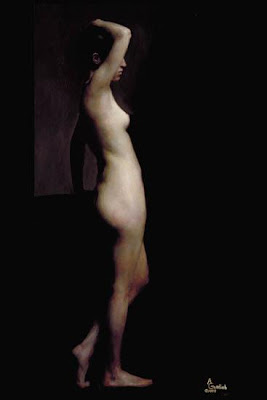CALCULATING THE MARKET PRICE FOR BEAUTY
In my opinion, Adrian Gottlieb is one of the finest young figurative painters working in the classical tradition today.

His elegant, timeless designs speak with quiet authority.


By contrast, the most financially successful figurative painter working in the classical style today is John Currin:

Currin lacks Gottlieb's talent, but this painting recently sold for $5,458,500-- hundreds of times more than a painting by Gottlieb.

Compare the work of these two artists and see if you can explain this huge disparity. I'll give you a hint: it has nothing to do with the quality of the images.

Mia Fineman, art critic for Slate, offers the following explanation for why the art market adores Currin:
What else might account for the high price of a Currin painting? I suspect that Currin's "post modern irony," his "mystery, sublimity, transcendence" and the rest of the airy persiflage used by oleaginous art dealers accounts for at least $5 million of that price. The fine art world continues to value derivative paintings for the very same qualities that it fails to admire in the original. Like the pop artists before him, Currin draws upon "low culture" sources such as 1950s advertisements, pin up art, internet pornography and high school yearbooks. Patrons of the arts would save a lot of money if they had the taste and vision to recognize the value in the originals. However these qualities remain invisible to them until some dealer with a continental accent and an expensive suit points out the "post modern irony" in the image.
It does not bother me that art dealers prey on the credulity of wealthy simpletons and the venality of art speculators. To the contrary, it serves an important social function: it is a tax on stupidity. The faster that such people can be stripped of their money, the less damage they will be able to do to society.

His elegant, timeless designs speak with quiet authority.


By contrast, the most financially successful figurative painter working in the classical style today is John Currin:

Currin lacks Gottlieb's talent, but this painting recently sold for $5,458,500-- hundreds of times more than a painting by Gottlieb.

Compare the work of these two artists and see if you can explain this huge disparity. I'll give you a hint: it has nothing to do with the quality of the images.

Mia Fineman, art critic for Slate, offers the following explanation for why the art market adores Currin:
This year, the name on everybody's lips is John Currin, whose midcareer retrospective recently arrived at the Whitney Museum. By now, the major critics have weighed in on Currin's slyly satirical, figurative paintings, and the reviews have been unusually enthusiastic. There are some wildly different ideas about exactly what Currin is up to—New York Times critic Michael Kimmelman sees him as "a latter-day Jeff Koons" trafficking in postmodern irony while Peter Schjeldahl at The New Yorker finds him a blissfully sincere artist tapping into the timeless values of "mystery, sublimity, transcendence." But everyone is unanimous about one thing: John Currin can paint. In almost every review, Currin's technical skill is acknowledged with a kind of breathless wonder.Currin's "technical skill" can't possibly account for his prices. Currin doesn't have the technical skill of Gil Evgren, let alone of Adrian Gottlieb. The level of technical skill that Fineman says excites "breathless wonder" in the fine art market is commonplace in the underpaid field of illustration. The contemporary fine art market turned its back on "technical skill" so long ago that it can no longer remember what skill looks like.
What else might account for the high price of a Currin painting? I suspect that Currin's "post modern irony," his "mystery, sublimity, transcendence" and the rest of the airy persiflage used by oleaginous art dealers accounts for at least $5 million of that price. The fine art world continues to value derivative paintings for the very same qualities that it fails to admire in the original. Like the pop artists before him, Currin draws upon "low culture" sources such as 1950s advertisements, pin up art, internet pornography and high school yearbooks. Patrons of the arts would save a lot of money if they had the taste and vision to recognize the value in the originals. However these qualities remain invisible to them until some dealer with a continental accent and an expensive suit points out the "post modern irony" in the image.
It does not bother me that art dealers prey on the credulity of wealthy simpletons and the venality of art speculators. To the contrary, it serves an important social function: it is a tax on stupidity. The faster that such people can be stripped of their money, the less damage they will be able to do to society.


